Discover how to create effective team development plans and goals for managers, boosting employee engagement and productivity in your organisation.
Working towards these milestones together will create a wonderful sense of comradery and purpose in your organisation.
Which is important because if the culture was better, 58 percent of respondents indicated that they would be willing to accept a position at a rival company.
In this blog post, we will explore the critical components of team development plans. We will also discuss the necessary steps for crafting effective plans that address common challenges faced by leaders in today's dynamic workspaces.
What is a team development plan?
A team development plan is a strategic roadmap designed to improve the overall performance and effectiveness of a team within an organisation.
It outlines objectives and activities to be completed by both managers and their teams, in order to reach the desired outcomes.
The importance of having such plans cannot be overstated as they help managers identify areas for improvement, allocate resources efficiently, and ensure that all members are working towards common objectives.
The purpose of team development plans
Aligning Goals: Ensuring that everyone on the team understands their role in achieving organisational objectives.
Fostering Collaboration: Encouraging teamwork through clear communication channels and collaboration tools.
Promoting Continuous Improvement: Identifying areas where the team can grow together by addressing skill gaps or improving processes.
Increase Employee Engagement: Empowering employees with opportunities for personal growth while contributing to the success of the company as a whole.
According to a LinkedIn report, over 25% of professionals in the field of learning and development utilise survey instruments for gauging the effectiveness of employee training programs. One such platform is Eletive.
Croisette used Eletive to create a dialogue between their employees and the manager. Preventing burnout, stress and illness. Watch the video below to find out how…
Croisette built a strong employer brand by focusing on the following…
Beyond performance metrics: focusing on growth
An essential aspect of any successful team development plan goes beyond merely evaluating current performance metrics.
Instead, it should focus on fostering growth among individual members so they can contribute effectively towards achieving collective goals.
By identifying strengths and weaknesses within each member's skill set or work style preferences - along with any gaps in knowledge or experience - managers can create targeted action plans that help employees develop their skills and achieve their full potential.
Creating a culture of continuous improvement
Another critical component of an effective team development plan is creating a culture where continuous improvement is encouraged and embraced.
This means not only addressing areas for growth but also celebrating successes, recognizing achievements, and providing constructive feedback to keep everyone motivated towards achieving the shared vision.
By fostering this type of environment, HR Managers can ensure that teams are consistently evolving and adapting to new challenges as they arise.
Steps for creating effective team development plans
Creating a successful team development plan requires careful planning and execution.
HR managers can ensure their teams are equipped to achieve goals and grow by taking the steps below…
1. Identifying team objectives
The first step in creating an effective team development plan is to identify the overall objectives of the team.
This involves understanding what the organisation expects from the team and aligning those expectations with individual goals.
Managers should collaborate with their teams to establish clear, measurable, and achievable targets.
2. Conducting a team assessment
A thorough team assessment helps managers understand each member's strengths, weaknesses, skills gaps, and areas for improvement. Assessment tools like Testlify help the respective managers to assess their employees with ease.
This information is crucial in developing targeted strategies that address specific needs within the group while fostering growth opportunities for all members.
3. Setting SMART goals for managers and teams
To ensure success in achieving desired outcomes, it's essential to set Specific, Measurable, Achievable, Relevant, and Time-bound (SMART) goals both at managerial levels as well as across entire teams.
S: Specific - Clearly define what you want to achieve;
M: Measurable - Establish criteria that allow progress tracking;
A: Achievable or Attainable - Set realistic yet challenging targets;
R: Relevant or Realistic - Ensure alignment with broader organisational goals;
T: Time-bound - Set deadlines for goal completion.
4. Developing a plan of action
Once goals are determined, it's essential to formulate a plan that delineates the necessary steps for their accomplishment.
This includes identifying necessary resources, assigning tasks and responsibilities, and setting milestones for progress tracking.
Managers should involve their teams in this process to ensure buy-in and commitment from all members.
5. Assigning roles and responsibilities
To maximise efficiency and effectiveness, managers must clearly define each team member's role within the group as well as their individual responsibilities related to achieving specific objectives.
This helps prevent confusion or duplication of efforts while promoting accountability among team members.
6. Establishing communication protocols
Maintaining open lines of communication is essential for successful teamwork; therefore, managers should establish protocols that facilitate information sharing among team members on a regular basis - such as weekly meetings or daily check-ins via email or messaging platforms like Slack.
7. Identifying resources needed for success
Last but not least, HR managers need to identify any additional resources required by their teams in order to meet established goals - including training programs, software tools (like Eletive) or other support services - ensuring they have everything they need at hand when tackling challenges head-on.
Creating effective team development plans requires managers to be thoughtful and intentional in their approach.
HR Managers should be knowledgeable in the necessary processes for successful team development planning, as difficulties can arise when attempting to put such plans into action.
Here’s what a team action plan looks like inside the Eletive platform…

Excel templates
To make this process easier we have suggested an easy to use template…
Discover: Employee development plan template
Common challenges with team development plans
Despite the importance of effective team development plans, there are several common challenges that can impede their successful implementation.
In this section, we will delve into these challenges and provide strategies for overcoming them.
Lack of clarity in objectives
One major challenge faced by managers when creating a team development plan is a lack of clarity regarding objectives.
To address this issue, it's crucial to identify specific goals that align with your organisation's overall mission and vision.
Ensure that all team members understand these objectives and work towards achieving them collectively.
Failure to assess team strengths and weaknesses
Skipping this step may lead to unrealistic expectations or missed opportunities for improvement.
Utilise tools like employee engagement surveys, performance reviews, or even informal discussions with your team members to gather valuable insights into their skills, knowledge gaps, and areas requiring further development.
Lack of effective communication
Poor communication can significantly impede the success of any team development plan.
Establishing clear communication protocols ensures everyone stays informed about progress updates, changes in priorities or responsibilities, as well as feedback from peers or supervisors.
Encourage open dialogue within the group through regular meetings where concerns can be addressed promptly.
Inadequate resources
Budget constraints: Limited budgets may prevent access to necessary training programs or hiring additional staff to support the team's growth. To overcome this challenge, consider exploring cost-effective alternatives like online courses or internal mentoring programs.
Time constraints: Balancing day-to-day tasks with professional development activities can be challenging for both managers and their teams. Schedule regular time slots dedicated to learning and improvement, ensuring that all members are committed to these sessions.
Resistance to change
Change is often met with resistance from employees who may feel threatened by new processes or expectations.
To minimise such reactions, involve your team in the planning process early on and communicate the benefits of implementing a development plan clearly. This will help foster a sense of ownership among team members while also promoting a positive attitude towards change.
Administering team growth plans can be an arduous assignment, as there are multiple possible obstructions that may emerge. With the right goals and objectives in place, managers can ensure their teams reach their full potential.

Examples of performance goals for managers, supervisors and teams
This segment provides examples of objectives which can be employed as a basis for formulating your team's development strategy.
Performance goals for managers
Improve leadership skills: Attend leadership training courses, seek feedback from employees on areas needing improvement, and implement changes based on feedback received.
Increase employee engagement: Utilise tools like Eletive to measure employee engagement levels and develop strategies to boost morale within the team.
Promote collaboration: Create opportunities for cross-functional projects or initiatives that encourage teamwork between departments.
Supervisor goals
Mentorship: Foster a mentoring culture by pairing experienced employees with new hires or those seeking career growth opportunities within the organisation.
Evaluate processes: Analyse current workflows to identify inefficiencies and implement improvements where necessary.
Enhance communication: Establish regular check-ins with team members to address concerns, provide updates, and gather input on ongoing projects.
Team development goals
Skill development: Identify skill gaps within the team and provide opportunities for training or workshops to help employees improve in these areas.
Conflict resolution: Implement strategies such as mediation, open dialogue, and team-building exercises to address conflicts within the team.
Achieve project milestones: Create SMART goals (Specific, Measurable, Achievable, Relevant, Time-bound) for each project phase and monitor progress towards achieving them.
Incorporating these examples into your team development plan will help create a more cohesive and productive work environment.
Remember that it is essential to customise these goals based on your organisation's specific needs and priorities.
Conclusion
By setting clear objectives and strategies, managers can lead their teams towards achieving both individual and collective milestones. This will instil a sense of camaraderie and purpose that is essential for a positive company culture.

But creating effective team development plans requires managers to be thoughtful and intentional in their approach, and difficulties can arise when attempting to put such plans into action.
Let us help you avoid those stumbling blocks and difficulties... Book a demo with Eletive here.
We’ll show you how easy putting a team development plan in place can be!

























